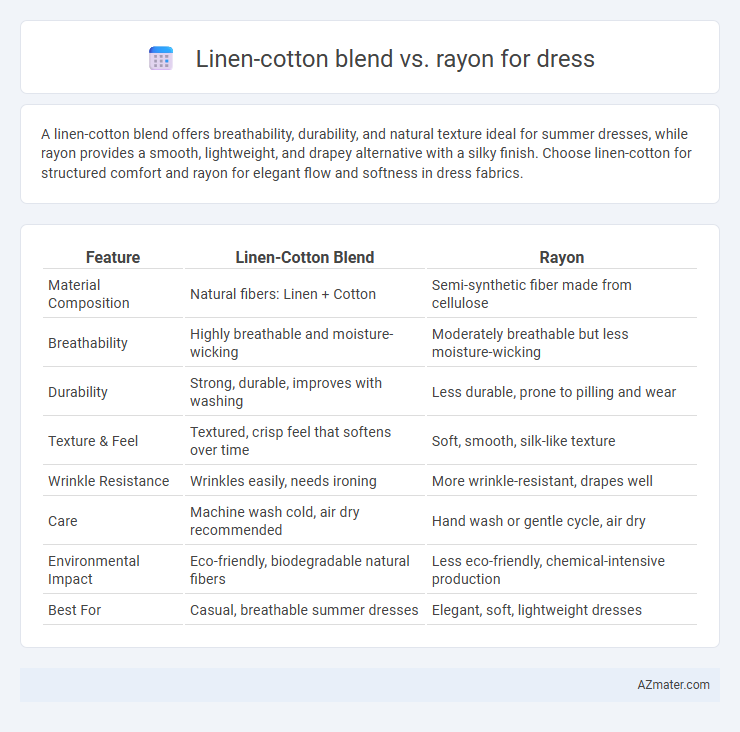A linen-cotton blend offers breathability, durability, and natural texture ideal for summer dresses, while rayon provides a smooth, lightweight, and drapey alternative with a silky finish. Choose linen-cotton for structured comfort and rayon for elegant flow and softness in dress fabrics.
Table of Comparison
| Feature | Linen-Cotton Blend | Rayon |
|---|---|---|
| Material Composition | Natural fibers: Linen + Cotton | Semi-synthetic fiber made from cellulose |
| Breathability | Highly breathable and moisture-wicking | Moderately breathable but less moisture-wicking |
| Durability | Strong, durable, improves with washing | Less durable, prone to pilling and wear |
| Texture & Feel | Textured, crisp feel that softens over time | Soft, smooth, silk-like texture |
| Wrinkle Resistance | Wrinkles easily, needs ironing | More wrinkle-resistant, drapes well |
| Care | Machine wash cold, air dry recommended | Hand wash or gentle cycle, air dry |
| Environmental Impact | Eco-friendly, biodegradable natural fibers | Less eco-friendly, chemical-intensive production |
| Best For | Casual, breathable summer dresses | Elegant, soft, lightweight dresses |
Introduction to Linen-Cotton Blends and Rayon
Linen-cotton blends combine the natural breathability and durability of linen with the softness and smoothness of cotton, creating a lightweight, comfortable fabric ideal for warm-weather dresses. Rayon, a semi-synthetic fiber made from regenerated cellulose, offers a silky texture and excellent drape, making it popular for flowy, elegant dress designs. Both fabrics provide distinct benefits: linen-cotton blends excel in moisture-wicking and breathability, while rayon emphasizes softness and fluid movement.
Fabric Composition and Sustainability
Linen-cotton blend fabrics combine natural fibers, offering breathability, durability, and a lower environmental impact due to fewer chemical processes and biodegradability. Rayon, a semi-synthetic fiber derived from cellulose, provides softness and drape but often involves energy-intensive production and significant water use, raising sustainability concerns. Choosing a linen-cotton blend supports eco-friendly fashion by utilizing renewable resources and minimizing pollution compared to rayon's chemical-heavy manufacturing.
Comfort and Breathability Comparison
Linen-cotton blends offer superior breathability due to natural fiber composition, allowing better airflow and moisture absorption, making them ideal for hot climates and extended wear. Rayon, a semi-synthetic fiber, provides a smooth, silky texture but tends to trap heat and moisture, reducing overall comfort in warm conditions. The linen-cotton blend's durability and moisture-wicking properties generally outperform rayon, ensuring a cooler, more comfortable experience in dresses.
Durability and Longevity
Linen-cotton blend fabrics exhibit superior durability and longevity compared to rayon, as natural fibers like linen and cotton resist wear and tear more effectively. The strength of flax fibers in linen combined with cotton's resilience ensures the garment maintains shape and texture over multiple washes. Rayon, a semi-synthetic fiber, tends to weaken and degrade faster under frequent use and laundering, which can shorten the lifespan of dresses made from it.
Care and Maintenance Requirements
Linen-cotton blends require gentle washing with cold water to prevent shrinkage and are best air-dried to maintain fabric integrity and softness. Rayon demands even more delicate care, often hand washing or using a gentle cycle with cold water, as it is prone to shrinking and losing shape when exposed to heat. Both fabrics benefit from minimal wringing and low-heat ironing to preserve fiber quality and appearance.
Environmental Impact of Each Fabric
Linen-cotton blends are more environmentally friendly than rayon due to their natural fiber content and lower water and chemical usage during production. Linen, derived from flax plants, requires minimal pesticides and moderate water, while cotton's environmental impact is higher but still less damaging than rayon's synthetic processes. Rayon, made from chemically treated wood pulp, often involves hazardous chemicals and significant water pollution, contributing to greater ecological harm compared to linen-cotton blends.
Aesthetic Qualities and Draping
Linen-cotton blend offers a natural, textured aesthetic with a slightly crisp drape that highlights structured silhouettes, creating a breathable and casual yet refined look. Rayon showcases a smooth, silky surface with excellent fluidity, producing elegant, flowing drapes ideal for dresses with graceful movement. Both fabrics excel in distinct visual and tactile qualities, with linen-cotton blends emphasizing organic texture and durability, while rayon prioritizes softness and drape versatility.
Cost Considerations for Dresses
Linen-cotton blends typically cost more than rayon due to the natural fibers and durability, offering better breathability and longevity for dresses. Rayon is usually more affordable, making it a budget-friendly option, but may wear out faster and require more delicate care. Choosing between the two depends on balancing initial cost with fabric performance and maintenance expenses.
Ideal Uses: Occasion and Season Suitability
Linen-cotton blends offer breathability and durability, making them ideal for casual summer dresses, outdoor events, and warm-weather office wear due to their moisture-wicking properties and natural texture. Rayon, known for its smooth, silk-like finish and excellent drape, suits formal occasions, evening wear, and transitional seasons like spring and fall, providing comfort and elegance in moderate climates. Both fabrics withstand moderate heat but linen-cotton blends excel in hot, humid conditions, while rayon's versatility adapts well to indoor environments and layered styling.
Final Verdict: Choosing the Best Fabric for Your Dress
Linen-cotton blends offer breathability, durability, and a natural texture ideal for casual and structured dresses, while rayon provides a smooth, lightweight, and drape-friendly option suitable for flowy, elegant designs. Choosing between the two depends on your preference for comfort and maintenance, as linen-cotton requires minimal care but can wrinkle easily, whereas rayon demands gentle handling to avoid shrinking. For long-lasting, breathable wear with a natural feel, linen-cotton is optimal, but for a sleek, soft finish and fluid drape, rayon remains the top choice.

Infographic: Linen-cotton blend vs Rayon for Dress
 azmater.com
azmater.com